Kashmir Great Lakes Trek: Ultimate Guide
- Trekking Destinations
-
Jun 15
- Share post
Are you an adventure enthusiast looking to embark on a thrilling journey amidst nature’s breathtaking beauty? Look no further than the Kashmir Great Lakes Trek.
Nestled in the picturesque region of Kashmir, this trek in India offers a mesmerizing experience that combines pristine alpine lakes, snow-capped mountains, and lush meadows.
This article explores the amazing trek and provides the information you need to plan an unforgettable adventure.
- Max Altitude: 13,750 Ft. (4,191M)
- Average Trekking Fees: ₹14,000 – ₹17,000
- Distance: 70 – 75 kms
- Difficulty: Moderate-Difficult
- Duration: 7-8 days
- Ideal For: Experienced Trekkers
- Best Season: July – September
- Region: Jammu & Kashmir
Table of Contents
ToggleOverview: A Glimpse of the Kashmir Great Lakes Trek

The KGL Trek is a mesmerizing adventure that takes you through some of the most stunning landscapes in the Indian Himalayas. This trek is renowned for its pristine alpine lakes, vibrant meadows, dense pine forests, and majestic snow-capped peaks. It offers a visual feast for nature lovers and avid trekkers alike.
The trek spans approximately 63 kilometres, usually completed in 7 to 8 days, starting from Sonamarg and concluding at Naranag. Along the way, trekkers are treated to seven breathtaking lakes, each with its distinct charm. From the serene Vishansar Lake to the mirrored beauty of Gangabal Lake, the shimmering waters create a surreal backdrop against the surrounding mountains.
The journey also presents diverse terrains, from gentle meandering trails to steep ascents, adding an element of challenge and thrill. Trekkers traverse through lush meadows adorned with colourful wildflowers, cross gushing streams, and navigate rocky paths, all while being enveloped in the grandeur of the Himalayas.
Camping under the starry skies and experiencing the remote mountainous region’s tranquillity adds to the trek’s overall charm. Trekkers often encounter local shepherds and nomads, providing a glimpse into this picturesque region’s traditional way of life.
With its awe-inspiring landscapes, azure lakes, and a sense of adventure at every step, the KGL Trek is a bucket-list-worthy experience that leaves an indelible mark on every trekker’s heart.
Additional Information for the Kashmir Great Lakes Trek
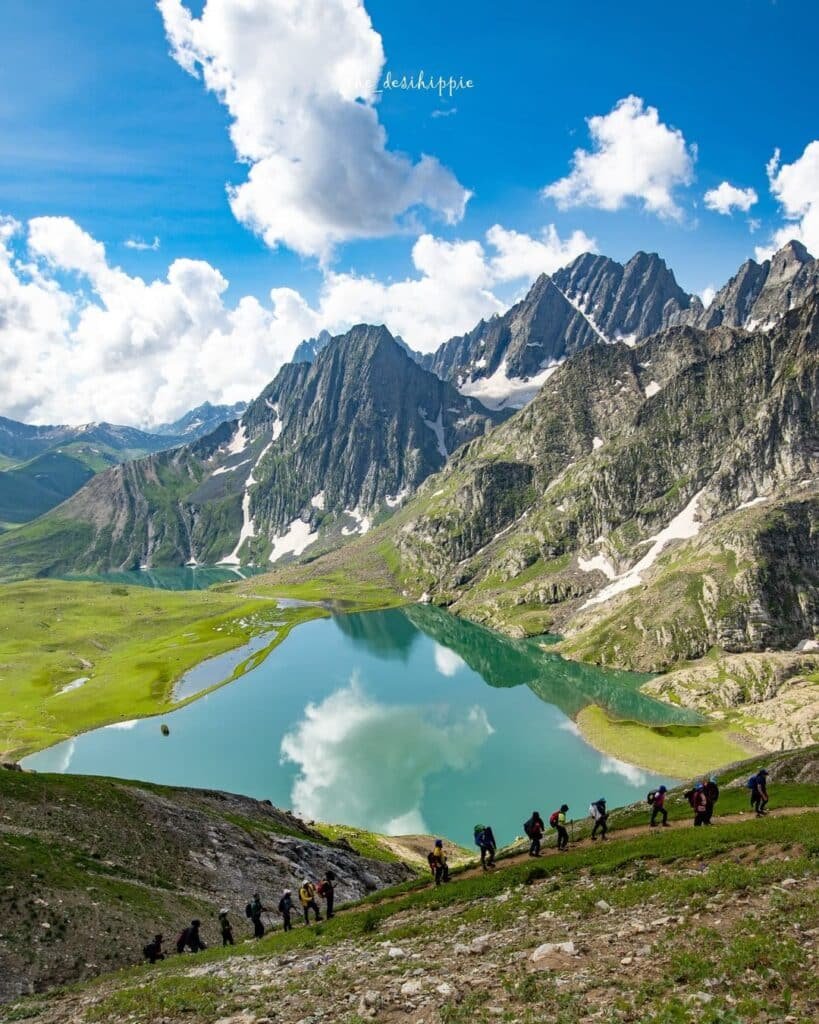
Trek Difficulty & Duration for the Kashmir Great Lakes Trek
The Trek offers moderate to difficult difficulty, making it suitable for experienced trekkers and those with a good fitness level. The trail involves gradual ascents and steep sections, with rugged terrain and occasional rocky patches. Trekkers should be prepared for varying weather conditions, including cold temperatures at higher altitudes.
The trek typically spans 7 to 8 days, covering a distance of approximately 70-75 kilometres from the base camp to the end point. Each day involves an average of 6 to 8 hours of trekking, allowing ample time to enjoy the breathtaking scenery and acclimatize to the altitude. It’s important to pace oneself, take regular breaks and stay hydrated.
Altitude sickness can be a concern on this trek, as it reaches heights above 4,191 meters (13,750 feet). Listening to experienced trek leaders and following their instructions regarding acclimatization and safety precautions is crucial.
While the trek requires a certain level of physical endurance, trekkers are rewarded with awe-inspiring views of the majestic Himalayan ranges, pristine lakes, and vibrant meadows. With proper preparation, including cardiovascular exercises and stamina-building activities, adventurers can fully enjoy the enchanting beauty of the KGL Trek.
Best Time For the Kashmir Great Lakes Trek
The best time to embark on the trek is during the monsoon months of July to September. This period offers favourable weather conditions and ensures a safe and enjoyable trekking experience.
During this time, the region experiences pleasant daytime temperatures are around 15°C to 25°C (59°F to 77°F) in lower altitudes. The nights can get very cold, with temperatures going as low as 5°C to 10°C (41°F to 50°F). The weather is relatively stable, with clear skies and minimal chances of rainfall, allowing trekkers to fully immerse themselves in the beauty of the surroundings.
Additionally, the monsoon months bring forth an abundance of colourful wildflowers and lush greenery, enhancing the visual appeal of the trek. The lakes are at their most enchanting, reflecting the surrounding mountains and creating stunning vistas.
It’s important to note that the region during the winter months there is a chance of heavy snowfall, making the trail inaccessible and increasing the risks associated with trekking. Monsoon season, from early July to mid-August, can bring unpredictable weather conditions and hinder the trekking experience.
Planning your trek between July and September lets you make the most of the pleasant weather, breathtaking landscapes, and optimal trail conditions, ensuring a memorable and safe trek.
Budget & Costing for the Trek
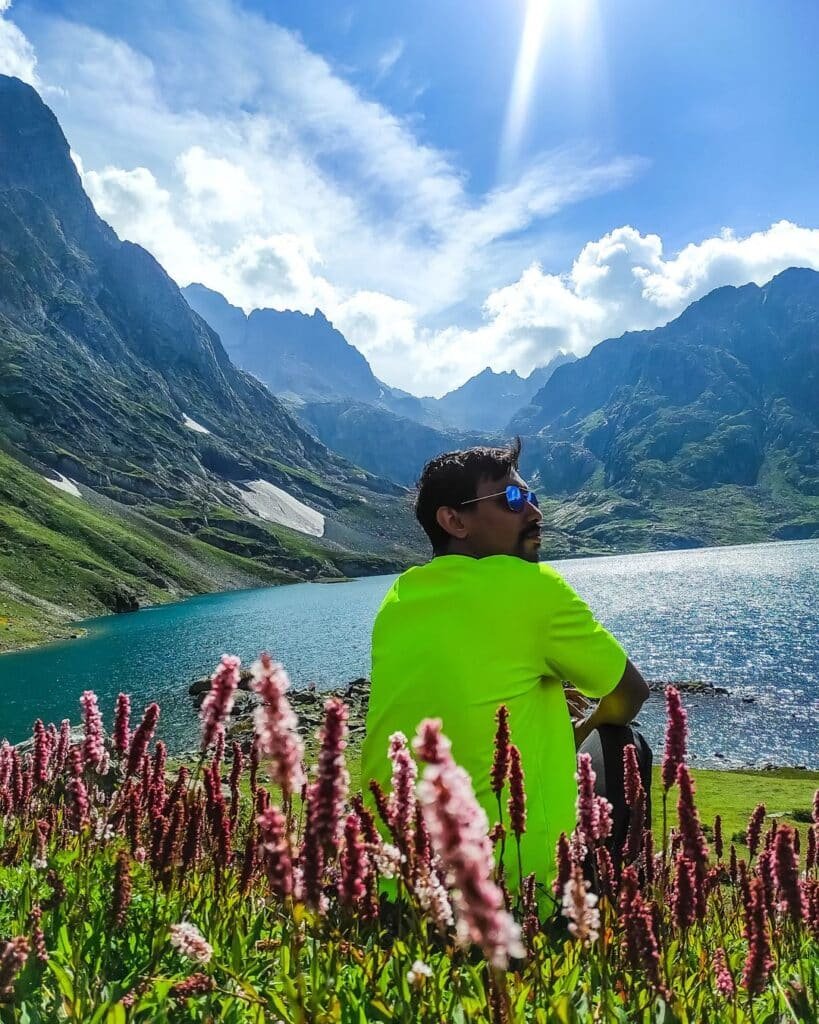
A breakdown of the costing and budgeting for the trek:
- Trekking Packages: Trekking packages are available from various trek operators and typically include services such as guides, porters, camping equipment, meals, permits, and transportation. The cost can range from approximately ₹14,000 to ₹17,000 per person, depending on the inclusions, duration, and quality of services.
- Travel Expenses:
- Flights: If you’re travelling from outside Jammu and Kashmir, you must budget for flights to Srinagar or Jammu. The cost can vary depending on the city you are flying from and the time of booking but generally ranges from ₹10,000 to ₹15,000 for a round trip from all the major cities in India.
- Local Transportation: Transportation from Srinagar or Jammu to the trek starting point (usually Sonamarg) and from the trek endpoint (usually Naranag) back to Srinagar or Jammu will incur additional costs, amounting to approximately ₹2,000 to ₹4,000.
- Accommodation: During the trek, accommodation is usually provided in tents by the trekking organisations.
- Food and Water: Most trek packages include meals during the trek. However, it’s advisable to carry some extra snacks and energy bars. Budget around ₹100 to ₹300 per day for additional food and water supplies.
- Miscellaneous Expenses: Consider setting aside a budget for miscellaneous expenses such as trekking gear, personal medication, tips for guides and porters, and any additional activities or souvenirs. Depending on your requirements, allocate around ₹2,000 to ₹5,000 for miscellaneous expenses.
It’s important to note that these figures are estimates and can vary based on factors such as the trek operator, individual preferences, and exchange rates.
Researching and comparing prices from different trek operators is recommended to find the best package that suits your budget and requirements.
How To Reach?
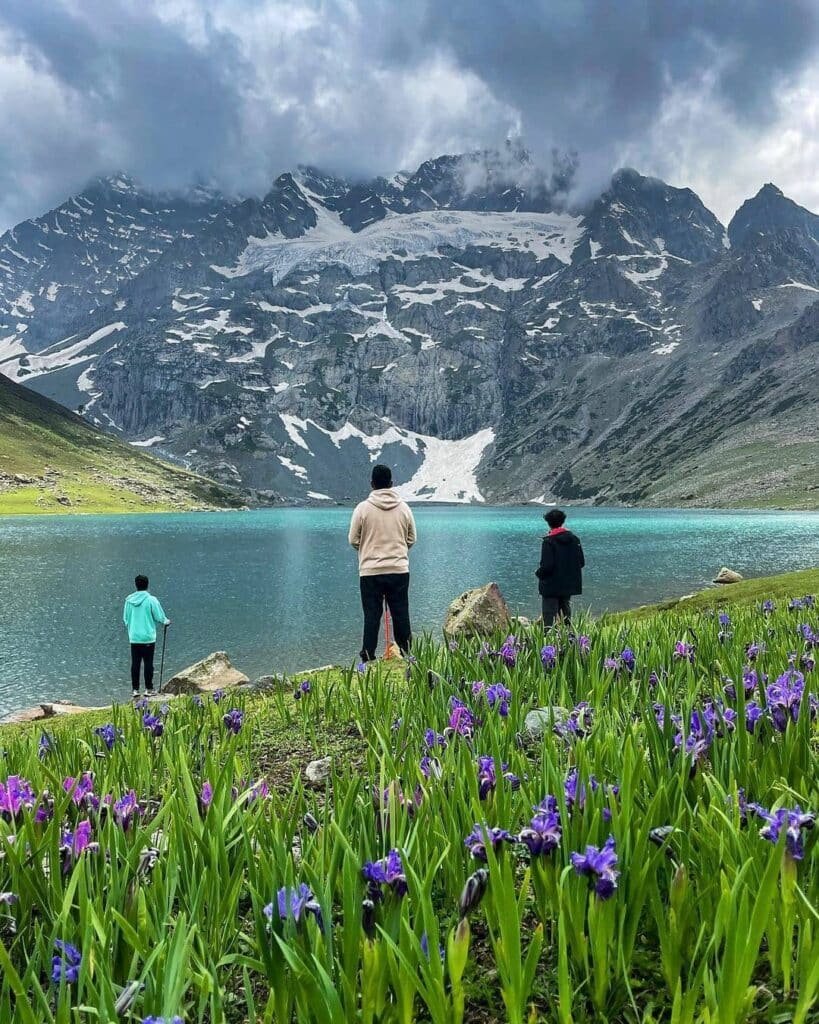
Reaching the start point of the trek involves travelling to Sonamarg, which serves as the gateway to the trek. Here are three standard modes of transportation to reach Sonamarg:
- Via Flights to Srinagar: The nearest airport to Sonamarg is the Srinagar International Airport. Several domestic airlines operate regular flights to Srinagar from major cities in India, including Delhi, Mumbai, Bangalore, and Kolkata. You can hire a pre-paid taxi from the airport or take a shared cab to reach Sonamarg. The journey from Srinagar to Sonamarg takes approximately 3 to 4 hours by road.
- Via Train: The nearest railway station to Sonamarg is the Jammu Tawi Railway Station in Jammu City. Jammu is well-connected to major cities in India by train. You can hire a taxi from Jammu or take a bus to Sonamarg. The journey from Jammu to Sonamarg takes around 8 to 9 hours, a distance of approximately 270 kilometres.
- Via Road: Sonamarg is accessible by road from Srinagar and other major regional cities. Srinagar is well-connected to cities like Delhi, Chandigarh, and Jammu by a network of national highways. You can drive to Sonamarg in a private vehicle or hire a taxi from Srinagar. The road journey from Srinagar to Sonamarg takes approximately 3 to 4 hours.
It’s important to note that road conditions in the mountainous region can be challenging, particularly during winters or adverse weather conditions.
It’s advisable to check the weather and road conditions beforehand and plan your journey accordingly. Hiring a local driver familiar with the terrain can also be beneficial.
Always leave ample time for travel, especially if you arrive on the same day as the trek departure. Reaching Sonamarg a day in advance is recommended to ensure a smooth start to your KGL Trek.
Detailed Itinerary For The Kashmir Great Lakes Trek
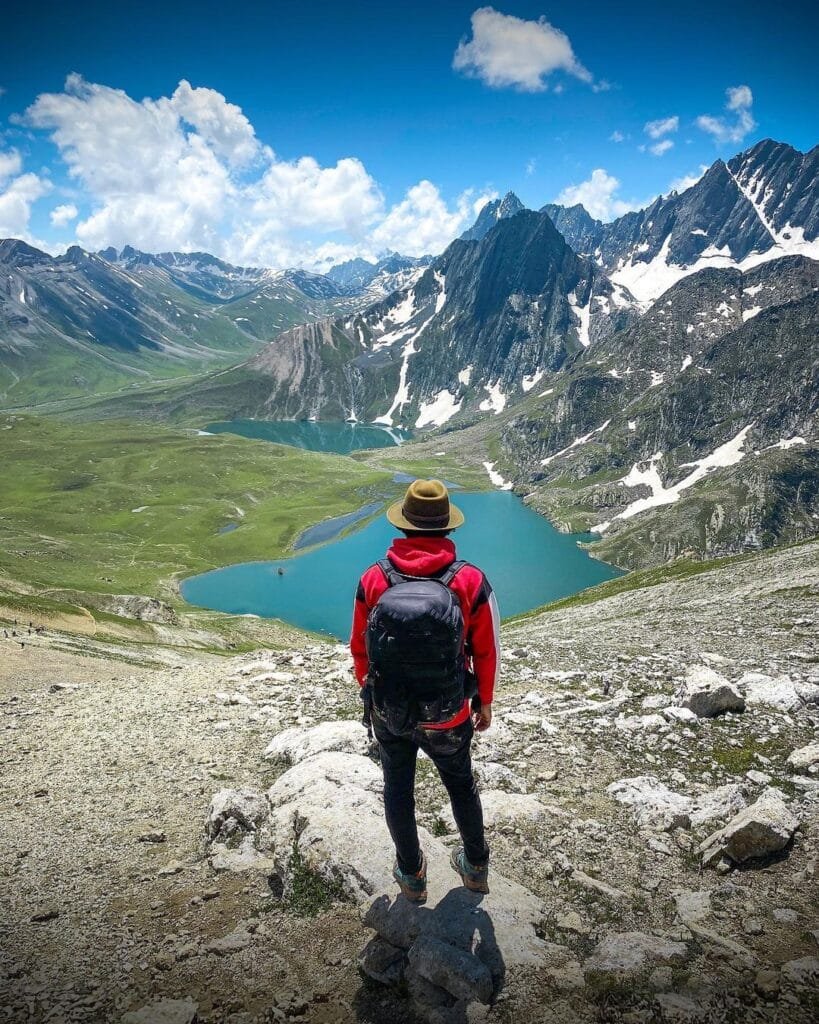
Day 1: Srinagar to Sonamarg
On the first day of the trek, you will begin your journey from the beautiful city of Srinagar, often called the “Venice of the East.” From Srinagar, you will travel to Sonamarg, the gateway to the trek. The scenic drive to Sonamarg takes you through picturesque landscapes, lush green meadows, pine trees and the gushing Sindh river.
Day 2: Sonamarg to Nichnai – 11 KM | 8 Hours
After a restful night in Sonamarg, your trekking adventure commences. The trail from Sonamarg to Nichnai is relatively moderate, allowing you to gradually acclimate to higher altitudes. As you hike through dense pine and maple forests, you will be captivated by the vibrant flora and fauna surrounding you.
Day 3: Nichnai to Vishansar Lake – 12 KM | 7 Hours
As you leave Nichnai behind, the trail leads you to the captivating Vishansar Lake via Nichnai Pass. This azure gem nestled amidst towering mountains will leave you amazed. The peaceful ambience and the mirror-like reflections of the mountains on the lake’s surface create a surreal setting.
Day 4: Vishansar Lake to Gadsar Lake – 14 KM | 10 Hours
Continuing your journey, you will trek from Vishansar Lake to Gadsar Lake via Gadsar Pass, known as the “Lake of Flowers.” The trail presents a stark contrast as you traverse the rocky terrain and witness the dramatic change in the landscape. Gadsar Lake, with its turquoise waters, surrounded by snow-clad peaks, offers a serene escape from the challenges of the trail.
Day 5: Gadsar Lake to Satsar Lake – 9 KM | 6 Hours
From Gadsar Lake, your next destination is the stunning Satsar Lake. This cluster of seven interconnected lakes, each with its distinct character, is a true marvel of nature. The tranquil ambience and the breathtaking views make this leg of the trek a memorable experience.
Day 6: Satsar Lake to Gangabal Twin Lakes – 11 KM | 6 Hours
The penultimate day of the trek takes you to the mesmerising Gangabal Twin Lakes. These twin lakes, nestled amidst pristine meadows and surrounded by lofty mountains, offer a sense of tranquillity and solitude. The reflections of the surrounding peaks on the crystal-clear waters create a magical sight.
Day 7: Gangabal Twin Lakes to Naranag – 15 KM | 7 Hours
On the final day of the trek, you bid farewell to the enchanting Gangabal Twin Lakes and make your way to Naranag. The trail descends through lush green meadows and picturesque landscapes, giving you a chance to reflect on your incredible journey.
Highlights of the Kashmir Great Lakes Trek
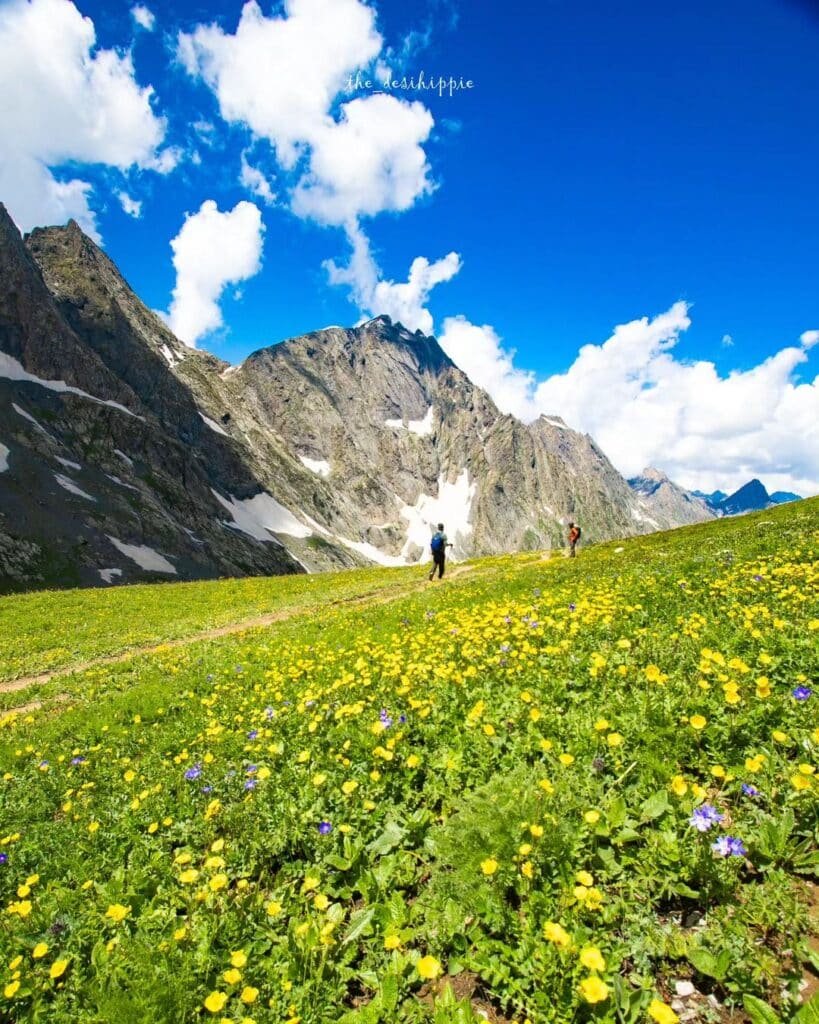
- Breathtaking Alpine Lakes: The trek showcases a series of seven stunning alpine lakes, each with its unique charm. From the crystal-clear waters of Vishansar and Krishansar Lakes to the picturesque Gangabal Lake nestled amidst snow-capped peaks, the beauty of these lakes is truly mesmerising. The tranquil surroundings and mirrored reflections create postcard-worthy vistas.
- Enchanting Landscapes of Kashmir: The trek takes you through some of the most awe-inspiring landscapes in Kashmir. From lush meadows adorned with colourful wildflowers to dense pine forests and majestic mountains, every step offers a feast for the eyes. The picturesque beauty of the region, with its rolling hills, towering peaks, and vibrant flora, showcases the natural splendour of the Himalayas.
- Challenging Trekking Experience: The trek provides a thrilling and rewarding experience. The trail involves a mix of moderate and challenging sections, including steep ascents and rocky terrain. It pushes trekkers out of their comfort zones, testing their physical endurance and mental resilience. Overcoming these challenges and reaching the high-altitude lakes brings excellent accomplishment.
- Immersion in the Kashmiri Culture: During the trek, trekkers interact with the local people, including shepherds and nomads. This allows for a cultural immersion experience, gaining insights into the traditional way of life in the region. Interacting with warm and welcoming locals adds a special touch to the trekking experience.
- Remote and Pristine Wilderness: Embark on an adventure into remote and untouched wilderness. The Kashmir Great Lakes Trek takes you through off-the-beaten-path trails, away from the hustle and bustle of civilisation. Experience the serenity and solitude of the mountains, surrounded by the pristine beauty of nature.
The Kashmir Great Lakes Trek truly captivates with its serene lakes, breathtaking landscapes, and the sense of adventure that comes with stepping out of one’s comfort zone.
Essential Gear and Equipment for the Trek
Before embarking on the trek, it is essential to pack the right gear and equipment to ensure a safe and comfortable journey. Here is a list of items you should consider carrying:
- Trekking shoes with good ankle support
- Backpack with rain cover
- Trekking gaiters
- Warm and waterproof clothing layers
- Sleeping bag suitable for sub-zero temperatures
- Trekking poles for better stability on uneven terrains
- UV-protected sunglasses and sunscreen
- Water bottles and water purification tablets
- Headlamp or flashlight with extra batteries
- First aid kit with essential medications
- Portable power bank for charging electronic devices
- Portable oxygen cylinders
Safety Tips & Precautions
While embarking on any trek, safety should always be a top priority. Here are some essential safety tips to keep in mind during the Kashmir Great Lakes Trek:
- Trek with an experienced guide and follow their instructions.
- Stay hydrated and carry an adequate supply of water.
- Pack light and carry only the essential items.
- Dress in layers to adapt to changing weather conditions.
- Respect the environment and maintain cleanliness.
- Inform someone about your trekking plans and expected return.
- Stay updated about weather conditions and local regulations.
- Avoid alcohol and smoking during the trek.
Conclusion
The Kashmir Great Lakes Trek is a journey of a lifetime, offering adventure seekers an unparalleled opportunity to witness nature’s grandeur.
From the tranquil alpine lakes to the majestic snow-capped peaks, every step of the trek is filled with awe-inspiring beauty.
So lace up your boots, pack your backpack, and prepare to embark on an unforgettable adventure in the paradise of Kashmir.
FAQs
The Great Lakes of Kashmir trek is moderately difficult and suitable for experienced trekkers. It involves steep ascents, rocky terrain, and high altitude, requiring good physical fitness and prior trekking experience.
The cost of trekking the Great Kashmir Lakes can vary depending on factors such as the trekking company, duration, and inclusions. The average cost ranges from ₹14,000 – ₹17,000 per person, covering permits, guides, accommodation, meals, and transportation.
The Kashmir Great Lakes trek is typically completed in 7 to 8 days. It covers a distance of approximately 70-75 kilometres through breathtaking landscapes, passing by the stunning alpine lakes of Kashmir.
The 7 Lakes trek near Srinagar refers to the Kashmir Great Lakes trek. It is called the 7 lakes trek because trekkers get to witness seven beautiful alpine lakes along the trail, including Vishansar Lake, Krishansar Lake, Gadsar Lake, Satsar Lake, Nundkol Lake, Gangabal Lake, and Naranag Lake. Each lake offers its own unique beauty and charm.
Comments
-
Please refer to our article: Trekking Shoes for more information.
Add a comment
Leave a Reply · Cancel reply
This site uses Akismet to reduce spam. Learn how your comment data is processed.

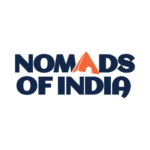
Yogiraj
November 14, 2023 at 11:30 amYour Ultimate Guide to the Kashmir Great Lakes Trek is a treasure trove of invaluable information! From detailed trail insights to practical tips, this guide is a must-read for anyone seeking an unforgettable adventure in the breathtaking landscapes of Kashmir.
Nomads of India
November 14, 2023 at 11:41 amThank you, Yogiraj for the kind words.